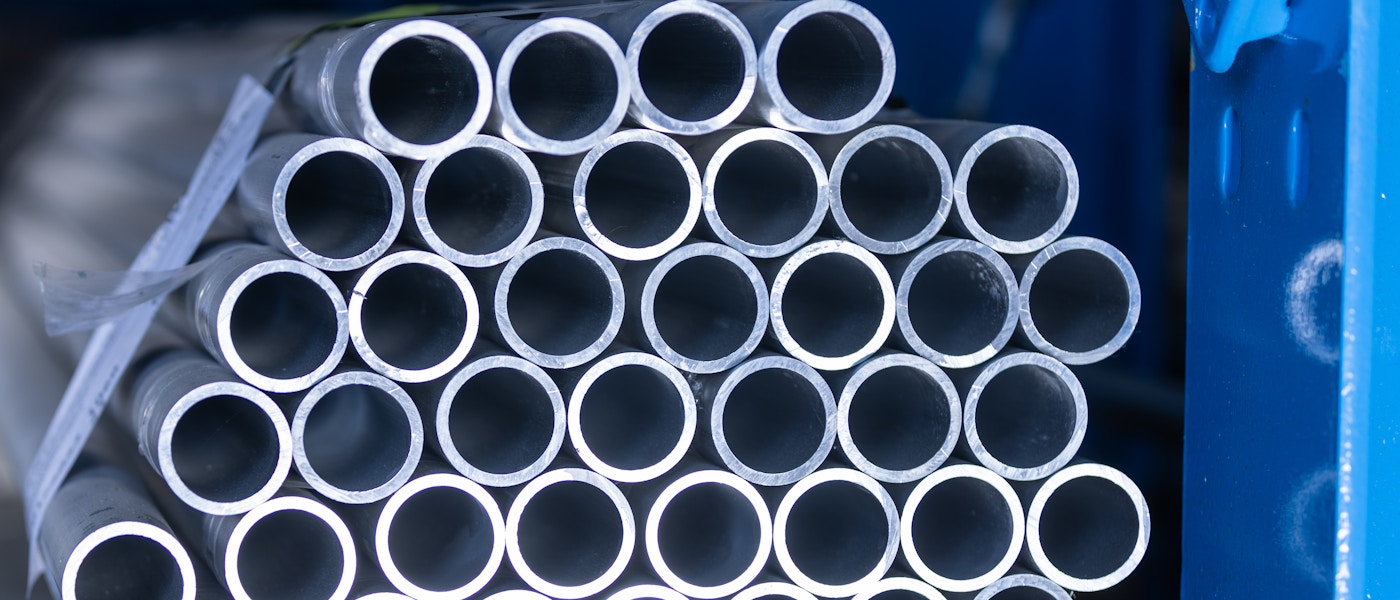Tubes or Pipes?
It is important to establish before we begin that tubes and pipes are actually different products.
The two products actually have different material tolerances and so are used within different commercial sectors and for different applications.
Pipes
A pipe is categorised as hollow and circular in design, it is commonly used for the transport of fluids and gasses specifically. Piping also has a different outside diameter and wall thickness to tubing.
Tubes
Tubing is commonly utilised in structural projects and can be any shape. Tubing is usually the more expensive because it often allows for tighter bends and more demanding tolerances when made.
The merits of Aluminium tubing and piping
Aluminium has only about 30% of the density of copper but has substantial thermal and electrical conductivity characteristics. It is also categorised as a superconductor due to its ability to conduct at very cold temperatures, so for tubing and piping projects in colder climates or micro-environments, aluminium can be much easy to move, install and relocate than other comparative solutions.
Aluminium also has many other notable characteristics such as excellent ductility and a high level of corrosion resistance, as well as being easy to cast, form, fabricate and machine, all of which make it an obvious choice for tubing and piping applications across the globe.
Types of aluminium pipe and tube
Square pipe and tube
Used when stronger tolerances are needed, tubes in a square design are stronger at the bend point.
Threaded aluminium pipe and tube
Can be welded without the need for joining, larger diameter threaded pipes will also need a form of a lattice as a supporting structure.
Anodised pipe and tube
Electrically treated to create extra oxide protection.
Spiral-welded aluminium pipe and tube
Taken from aluminium plates cut in spirals.
Section pipe and tube
Used in larger projects such as fuselage for aircraft, section pipes are fitted together using threaded joints. Aluminium’s lightweight nature makes it ideal for this task.
Performance requirements for aluminium tubes and pipes
Before tubes and pipes can be sold they need to meet industry standards. Every tube or pipe must meet these criteria in order to be of sellable quality.
Pressure Rate:
This test assesses the maximum and minimum pressures a tube can manage. This is especially important when tubes and pipes are designed to carry liquid.
Temperature levels:
Assessing the complete scope of ambient temperature the desired tube or pipe can support. This is a vital consideration where high temperatures are a pivotal need.
Maximum vacuum rating:
The highest pressure that the inside walls of the tube can withstand.
Minimum bend radius:
Assesses the deformation of a tube's cross-sectional points and their resistance levels.
Different types of tubing and pipes
Different applications require different tube types, the following are the more common of these options:
Coiled or spiral?
Coiled and spiral tubing must have enough flexibility to run a wrapped reel spring so that it doesn’t break in real-world applications.
Sterilised or not?
There are multiple sterilisation techniques when this is a pre-requisite. Among these are gamma irradiation, disinfecting, autoclaving, and dry-heat chemical processing.
Fins or flutes?
Creating space for heat to dissipate is of course key in some industries, for refrigeration and air conditioning, for example, this design is pivotal for the product to work efficiently and without issues.
Aluminium’s alloying potential
What it lacks in raw strength versus the toughest of metals, aluminium more than makes up for with its alloying values.
Its incredible adaptability as an alloying metal allows it to be mixed in so many multiple compositions that almost any task becomes possible.
When it comes to performing more than one function such as anti-corrosive while being eye pleasing and yet easy to transport and re-install such as in outdoor advertising.
Or non-sparking and non-magnetic yet still easy to machine and form such as when making tools. Aluminium is a standout choice.
These are just two examples of its extremely vast alloying potential, and once we expand this to its whole range of possibilities, we can see why aluminium truly is the chameleon of metals.
In recent times many new alloys have been discovered and the capabilities widened far beyond any expected scope, and with aluminium’s natural abundance, this trend seems set to continue long into the future.
Common alloying elements used in piping and tubing
The most often used grades across today’s industrial landscape are 2024, 3003, 6061 and 7075.
These are usually combined with the alloying elements of magnesium, silicon, copper, zinc and manganese to create various performance characteristics.
Key reasons to choose a specific grade of aluminium tubing include how lightweight it is, its thermal or electrical conductivity and how it performs in a corrosive environment.
For example, an aircraft engineering team would choose 7075, 2024 and 6061 because of their higher strength-to-weight ratio and solid fatigue resistance.
If untreated 7075 and 2024 both have the drawback of corrosion weakness, whereas 6061 boasts higher natural corrosion resistance and is also simpler to weld.
7075’s natural properties make it a tougher but also more expensive material.
In comparison to those, alloy 3003 in the wrought aluminium/manganese family is ideal for projects that need both high strength and corrosion resistance, but with lower ductility performance.
Or where multiple joints are needed, a material such as alloy 5052 using magnesium and chromium would be preferred.
Tempering
The various performance characteristics of any given alloy are created by its heat treatment method or tempering level.
The tempers themselves denote specific properties. Beginning this scale is a temper of O which signifies a hardened material at peak ductility level and poorest strength ratio.
The more common ‘T’ tempers such as T6, T4 and T3 are all reached with heat treatment followed by ageing methods or cold working to anneal the metal and harden its composition.
Once an alloy and temper is chosen, it is important to look at specifics such as dimensions and any required additional fabrication.
Righton Blackburns are able to source any metal you may have in mind or indeed suggest an ideal solution for any given project.
We can also professionally fabricate, shear, bend, cut and machine to exact specifications.
How to manufacture Aluminium tubes and pipes
The Aluminium extrusion process
Before pipes and tubes come to market, they of course first need to be made, this begins with the process of extrusion.
Overall, the extrusion process can be generalised as a procedure of pushing an alloyed metal through the die of an allocated cross-sectional shape.
It is much like the mechanics of squeezing toothpaste from a tube where a mass is narrowed to a specific hole and comes out as circular material.
When applied to metal, this methodology is more industrial and involves the use of a powerful ram that forces the aluminium through the die shape.
This is then pulled over an area called a runout table to allow the material to cool before further processing.
Below is this process in more detail.
Step 1.
From extrusion die to extrusion press
Before extrusion, the die is pre-heated to between 450 and 500°C to help sustain its longevity and create an even flow of metal, this is in then placed into the extrusion press.
Step 2.
Preheating aluminium billets before extrusion
For the next part of the procedure we cut a circular section from a long piece of pre-alloyed material, this section is known as a ‘billet’.
This billet is then placed in a specialised oven at a pre-heated temperature of between 400°C and 500°C.
This temperature allows the material to become malleable, but not so hot that it becomes molten.
Step 3.
Moving the billet to the extrusion press
Once the billet has been pre-heated, a release agent or lubricant is applied.
The lubricant or release agent is also used on the ram to avoid both the billet and ram from sticking to each other.
Step 4.
Loading the billet into the container
The now malleable billet can now be loaded into the extrusion press, and a hydraulic ram puts around 15000 tonnes of pressure onto it.
As this pressure is exerted the billet is forced into the ‘extrusion press container’ where the metal increases in size and fills out the space within the container.
Step 5.
Extruding the solid mass
As the container fills, the mass is pushed up towards the die, again much as the paste in a toothpaste tube pushes at the round hole.
As the pressure continues, the metal is forced through the allocated die shape, in this case, as a tube or pipe.
Step 6.
How to ‘run’ and ‘quench’ an extrusion
As it emerges from the die, a puller grips the extrusion and pulls it across the runout table, this is done at a matching speed as the runout table is operating.
As it travels the tube is consistently cooled using a fan situated above the table or by water bath, this is known in the process as the quenching stage.
Step 7.
Cutting
Once an extrusion reaches the length of the runout table, it is then cut by a heated saw, thus completing the extrusion part of the process.
Throughout all these steps temperature plays a pivotal role and that remains true for the next part of the process.
Step 8.
Cooling
Once cut, the extrusion is moved from the runout table to a cooling area. The newly extruded tubes remain here until they reach room temperature and at this point, they can be stretched.
Step 9.
Stretching
Often tubes and pipes will come out of the extrusion process with only a rough definition and will need to be straightened to remove inaccuracies, this process is known as ‘stretching’. To do this we use a stretch-press which works by gripping the metal at both ends and pulling until the desired form is reached.
This is of course done by professional technicians with preset tolerances already taken into account.
Step 10.
Cutting finished extrusions to length
At this stage the extrusion though mostly finished is still the length of the runout table, and will still need to be cut to size.
Currently, the chemical properties are that of a T4 temper which enables the extrusion to be cut. Once cut, they can then be artificially aged in an oven to create the much more commercially viable T6 or T5 tempers.
Step 11.
Heat treatment, fabrication and finishing
Once an extrusion procedure is complete, pipes and tubes can then be heat-treated to enhance their various mechanical and chemical strengths such as ductility and corrosion resistance.
After this, there are several options to finish the metal to bolster aesthetic appearance and trim down any unwanted edges or remaining roughness.
What does heat treating do?
In a nutshell, heat treatment is used to improve a metal's mechanical capabilities.
A key example of this is when referencing the 7000, 6000 and 2000 series alloys that utilise heat treatment to enhance their yield stress level and tensile strength.
This is done by placing tubes into an ageing oven, what this does is to ‘speed up’ the evolution of a metal's chemical properties, and this means that stronger and more resilient tempers can be created on demand.
Options for finishing aluminium tubing
Aluminium pipes and tubes can be finished in a variety of ways.
Among the more popular of these processes are:
Anodising
Thickens the oxide layer, improving corrosion resistance and allowing the application of dyes.
Powder coating
Powder coating involves spraying and curing a metal’s surface enhancing both corrosion and wear resistance.
Sand Blasting
Using an abrasive substance to remove impurities and present and clean polished look.
Sublimination
Creating a wood look by using ink and heat to print onto the metal.
Aluminium can also be painted, and though it is not the easiest metal to paint, there are many articles available on the net that demonstrate how to do this safely and with a minimum of fuss.
Recycling
These days, recycling is a pivotal factor when deciding on the best materials for your project and for the planet.
For this purpose aluminium has no equal, it can readily be melted down without losing any of its natural chemical properties and is therefore almost 100% recyclable.
Re-using aluminium is also an exceptionally cost-effective material and generates a fraction of the overall energy that other comparative metals may need.
In fact, much of today’s ‘new’ aluminium is in fact recycled and has been used multiple times but still performs to exactly the same standard and creates the same aesthetic quality.



